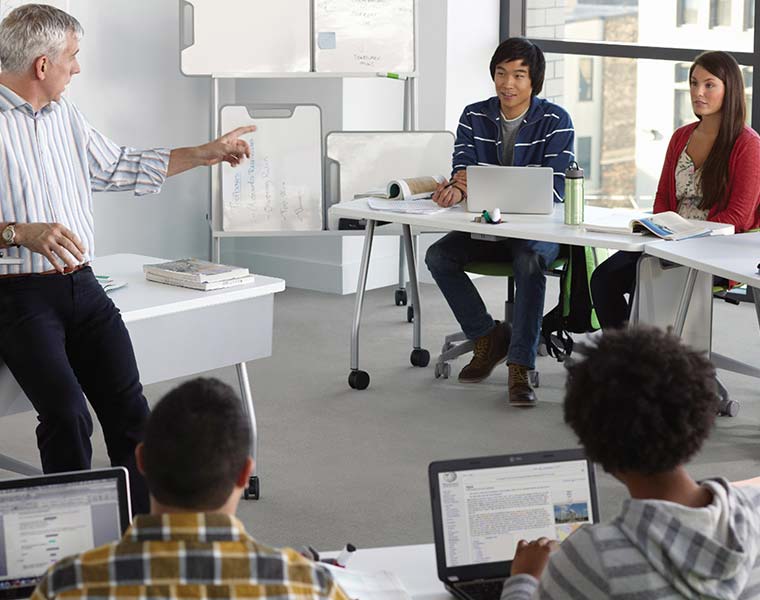Here at Penketh Interiors, you know how we like to stay two steps ahead of the trends. Earlier this year it was the continuation of biophilic office design and the rise of inclusive workspaces – this time, it’s the idea of active and ‘blended learning’.
In fact, last year, Steelcase ran extensive research on the topic which involved 60 interviews, observations at 24 schools, four workshops and two university collaborations. This, combined with more recent briefs from our own customers tell us that this is more than just a trend.
Blended learning is a movement in workspace interior design that is accommodating a shift in control as students transition from passive listeners to active participants.
Of course, users need a strategically designed space, portfolio of furniture and adequate technology in order to make blended learning work. Before we explore that in more depth though, let’s first come to an understanding of what the concept is all about.
What is blended learning?
Blended learning is a concept coined by Steelcase and describes “an approach to teaching which combines online and face-to-face learning” and accommodates multiple learning situations.
It extends beyond traditional methods of teaching and conventional learning environments into more agile and versatile spaces such as virtual learning and collaborative idea-sharing.
“Where high-tech and low-tech co-exist”
Students these days expect to see technology incorporated as part of their programmes or courses and expect to be able to use digital tools as means to learn.
Blended learning is about integrating this with more classic methods of teaching.
The benefits of blended learning
As part of their global research, Steelcase dedicate a great deal of resource into the education sector. They utilise everything from cognitive neuroscience and behavioural studies to gain a better understanding of how people want to teach and learn.
From this research, it’s clear that blended learning is where we’re headed.
Of course, there will always be a number of people who champion traditional and there are many who still feel safe in the realms of lecture rooms and static seating. That said, there is a whole multitude of advantages that a more active and blended approach can bring to any training or learning space.
These include:
- A personalised pace of learning which breaks down the one-size-fits-all approach
- Improved remote participation for mobile or long-distance students and teachers
- More streamline idea-sharing and communication of information
- Increased choice and control for students around where, how and when they absorb information
- The normalising of social interaction and collaborative communication within the learning environment
- Increased physical movement around the workspace for better cognitive function and overall wellbeing
How to cater for different styles of learning
As attitudes and perceptions evolve, approaches to workspace design and how learning environments are used need to as well. Along with space-planning, furniture and technology, cultures also need to align in order to make blended and active learning viable.
As we’ve mentioned before, space and culture are intrinsically connected so let’s look at how you can facilitate more diverse learning styles through workspace design and product selection…
Make furniture more mobile and ergonomic
As training and learning spaces gradually move away from traditional lecture seating and sedentary speak-and-listen cultures, furniture needs to respond. Opt for modular and portable furniture which can be easily moved around the space according to requirement.
Steelcase Node (pictured below) is a great example of this and a popular seating solution amongst our customers within the education sector.
Reconsider configuration of the space
A culture and attitude change calls often call for a reimagining of how a space flows and that is certainly true in this case.
Consider creating small settings around the edges or just outside of the learning space for impromptu meetings or private chats. Another example would be to include high stools and tables as an alternative to the architecturally tiered flooring which limits movement around the space and interaction.
Introduce technology as a learning and teaching tool
It goes without saying that face-to-face connections will still be a vital part of learning processes but as we mentioned earlier, technology is reshaping the world of learning.
Screen sharing technology such as Clickshare, media:scape and video conferencing will become common place in a blended learning environment. SMART Boards means audio and video content can be easily stored and shared away from the physical workspace.
Facilitate both digital and analogue learning
The objective of blended learning is to merge online and offline teaching and learning methods. So, in order for it to work, you will need to cater for both digital and analogue styles.
Something like Steelcase Verb (pictured above) is an intuitive collection of products which work together to accommodate multiple learning styles. Rolling desk can be manoeuvred around the space to improve screen viewing, while individual whiteboards encourage those who prefer analogue methods.
Click for more reading on how to cater for both digital and analogue creativity in the workplace.
